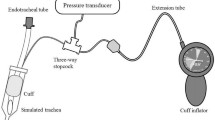Summary
A new parachute cuff has been tested in combination with a positive end-expiratory pressure (PEEP) on mongrel dogs. During positive-pressure ventilation the intracuff and intratracheal pressures showed synchronous, identical pressure variations, and therefore theoretically with this type of cuff the pressure against the tracheal wall would be minimal.
The cuff provided a seal against gas leakage from the lungs throughout the entire test period, i.e., for up to 7 h. To avoid aspiration of mouth contents during the passive exhalation phase, different amounts of PEEP were tested. A PEEP of 4.0–8.0 cm H2O always produced a seal against a column of fluid in the mouth exerting a hydrostatic pressure of 5.4–8.8 cm H2O against the cuff. This seal was maintained during the whole test period. No difference in sealing capacity was found when the cuff was used with a normal respiratory frequency (20/min) and with high-frequency positive-pressure ventilation (60/min).
When the PEEP is eliminated, e.g., when the respirator is disconnected for suction of the endotracheal tube, the sealing effect will be abolished. As the cuff extends up into the larynx there will be no pooling of fluid above the cuff. The risk of aspiration can therefore be diminished by suction of the oral cavity before disconnecting the respirator. With the use of the pneumatic valve principle together with high-frequency positive-pressure ventilation, an open respirator system can produce a continuous PEEP, thereby preventing aspiration even during suctioning of the tracheal tube.
Similar content being viewed by others
References
Borg, U., Lyttkens, L., Nilsson, L.-G., Sjöstrand, U.: Physiologic evaluation of the HFPPV pneumatic valve principle and PEEP. — An experimental study. Acta Anaesthesiol. Scand. [Suppl.] 64, 37 (1977)
Finley, T. N., Abouav, J.: Self-inflating parachute cuff. Am. J. Surg. 12, 657 (1973)
Grillo, H. C.: Surgery of the trachea. Current problems in surgery, p. 3. Chicago: Year book medical publishers, Inc. 1970
Jackson, R. R., Rokowski, W. J.: An endotracheal tube with a cellophane cuff. Arch. Surg. 94, 160 (1967)
Martinez, H. E.: An improved cuffed tracheostomy tube for use with intermittent positive pressure breathing. J. Thorac. Cardiovasc. Surg. 47, 404 (1964)
Merav, A. D.: Low-pressure “parachute” endotracheal cuff. N.Y. State J. Med. 71, 1926 (1971)
Nordin, U.: The trachea and cuff-induced tracheal injury. An experimental study on causative factors and prevention. Acta Otolaryngol. [Suppl.] (Stockh.) 345 (1977)
Nordin, U., Lindholm, C.-E., Wolgast, M.: Blood flow in the rabbit tracheal mucosa under normal conditions and under the influence of tracheal intubation. Acta Anaesthesiol. Scand. 21, 81 (1977)
Nordin, U., Lyttkens, L.: New self-adjusting cuff for tracheal tubes. Acta Otolaryngol. (Stockh.) 82, 455 (1976)
Nordström, L.: On automatic ventilation. Acta Anaesthesiol. Scand. [Suppl.] 42, 12 (1972)
Revenäs, B., Lindholm, C.-E.: Pressure and volume changes in tracheal tube cuffs during anesthesia. Acta Anaesthesiol. Scand. 20, 321 (1976)
Sjöstrand, U.: Review of the physiological rationale for and development of high-frequency positivepressure ventilation — HFPPV. Acta Anaesthesiol. Scand. [Suppl.] 64, 7 (1977)
Stanley, T. H.: Nitrous oxide and pressures and volumes of high and low-pressure endotracheal-tube cuffs in intubated patients. Anesthesiology 42, 637 (1975)
Author information
Authors and Affiliations
Additional information
This work was financially supported by the Swedish Medical Research Council (Projects No. B 76-17X4259-03 and No. 4252)
Rights and permissions
About this article
Cite this article
Nordin, U., Lyttkens, L. New parachute cuff and positive end-expiratory pressure to minimize tracheal injury and prevent aspiration. Arch Otorhinolaryngol 222, 119–125 (1979). https://doi.org/10.1007/BF00469751
Received:
Issue Date:
DOI: https://doi.org/10.1007/BF00469751




